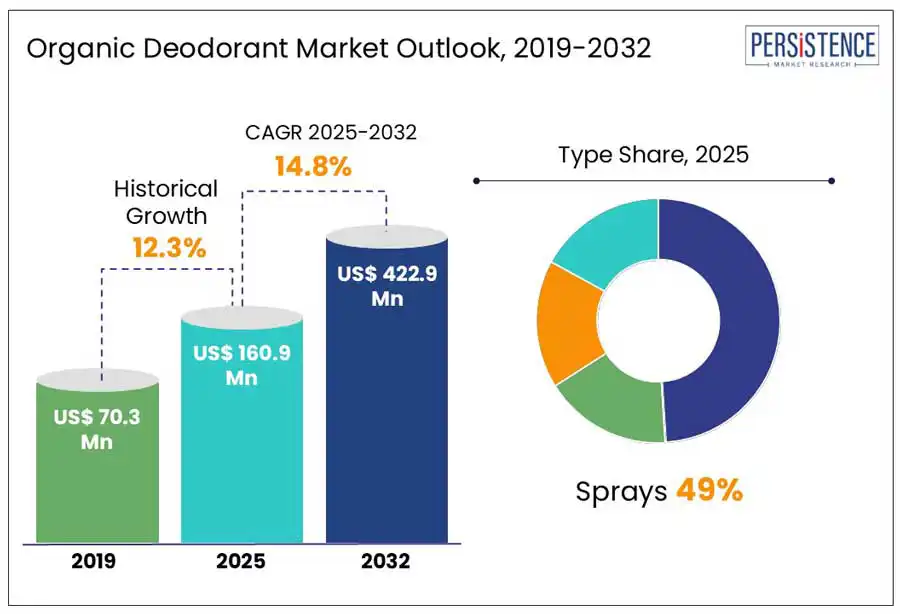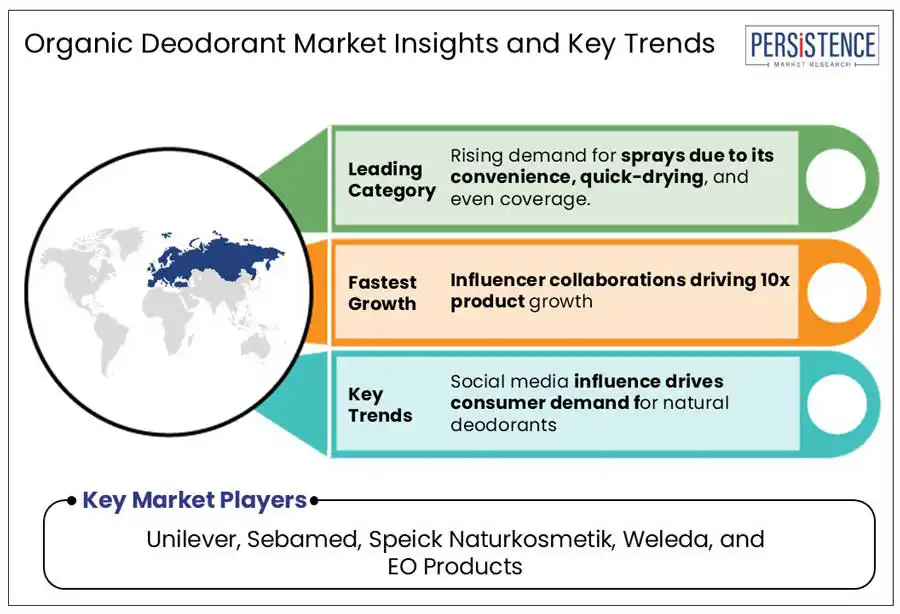Comprehensive Snapshot for Organic Deodorant Market Including Regional and Country Analysis in Brief
Industry: Consumer Goods
Published Date: April-2025
Format: PPT*, PDF, EXCEL
Delivery Timelines: Contact Sales
Number of Pages: 140
Report ID: PMRREP35246
The global organic deodorant market size is projected to be valued at US$ 160.9 Mn in 2025 and register a CAGR of 14.8% from 2025 to 2032. The market is likely to reach US$ 422.9 Mn by 2032. According to Persistence Market Research, the global demand for organic deodorants is witnessing significant growth on account of growing health consciousness as consumers seek to avoid potentially harmful chemicals such as aluminum and parabens commonly found in conventional products. This shift aligns with the broader clean beauty movement, where individuals prefer transparent labels and plant-based ingredients that are gentler on sensitive skin.
As consumers continue to prioritize wellness and sustainability, the demand for organic deodorants is expected to increase, driving innovation in both formulation and packaging. Brands are not only focusing on eco-friendly and recyclable materials but also incorporating advanced technologies to create more personalized and effective products. Besides, the growing personal care industry globally is anticipated to further create significant growth opportunities in the forthcoming years.

Key Industry Highlights
|
Global Market Attribute |
Key Insights |
|
Organic Deodorant Market Size (2025E) |
US$ 160.9 Mn |
|
Market Value Forecast (2032F) |
US$ 422.9 Mn |
|
Projected Growth (CAGR 2025 to 2032) |
14.8% |
|
Historical Market Growth (CAGR 2019 to 2024) |
12.3% |
Social media is turning out to be an X factor for companies. Consumers, primarily millennial and Gen Z consumers, are prioritizing transparency and authenticity. Platforms such as Instagram, Facebook, and TikTok have amplified grassroots movements where individuals share personal experiences of skin reactions to traditional deodorants, leading to viral discussions and increased demand for natural alternatives. This organic word-of-mouth marketing has prompted brands to adopt more transparent labeling and ingredient sourcing to align with consumer expectations. For instance, in March 2025, Unilever announced that it would be increasing its influencer marketing budget from 30% to 50% of its total advertising spend, aiming to rebuild consumer trust through authentic endorsements.
Moreover, the rise of influencer-led social media campaigns focusing on clean beauty and wellness has further propelled the popularity of organic deodorants. These influencers often share detailed reviews and tutorials, educating their followers on the benefits of aluminum-free and hypoallergenic products. Their endorsements not only boost product visibility but also foster a sense of community among consumers who value natural and ethical personal care options. This trend emphasizes a considerable shift towards consumer-driven marketing, where social media influence is shaping consumer purchasing decisions globally.
Unlike conventional deodorants that use synthetic stabilizers and preservatives, organic formulations often rely on natural ingredients that are more sensitive to temperature, humidity, and shelf life. This can lead to common issues such as product separation, reduced efficacy, or spoilage, particularly in warmer climates or regions with less developed cold-chain logistics. For example, when Schmidt’s Naturals first scaled its operations, some batches of its baking soda-based deodorants faced complaints about texture separation, graininess, and product melting during shipping in warmer climates. These issues were most common in regions of Southern US, Australia, and Southeast Asia, where ambient temperatures during transit often exceeded the product’s stability.
Consumers expect natural deodorants to perform as effectively as synthetic perfumes. As a result, limited shelf life or product stability is anticipated to hinder market growth to a certain extent. However, companies are likely to invest in research and development activities to launch innovative products without compromising ingredient integrity.
Today, consumers are becoming increasingly conscious about their personal care product, as well the ingredient sources. For organic deodorant companies, this has created a unique opportunity to build competitive advantage through radical transparency. Consumers are drawn to brands that provide detailed insight into sourcing practices, ingredient origins, and ethical production processes. Certifications such as COSMOS Organic, Fair Trade, or Ecocert are now more than marketing badges; they are trust signals that directly influence purchasing decisions in this dynamic market. As per studies, 75% of consumers globally expect personalized experiences from their beauty brands.
To strengthen this connection, some brands are incorporating QR codes on packaging that link to in-depth sourcing stories, farmer cooperatives, and production standards. Others are building full ingredient traceability platforms, where consumers can follow a product's journey from raw material to shelf. Such initiatives by companies in maintaining transparency among consumers are anticipated to create significant growth prospects and differentiate themselves from the competition.
On the basis of type, the market is segmented into roll-ons, sprays, sticks, and creams. The Sprays are expected to lead and account for a share of about 49% in 2025. Consumers favor sprays for their ease of application, quick-drying properties, and convenience, which is best suited for on-the-go lifestyles. The appeal of even coverage and a refreshing feel has further boosted their popularity. Additionally, the introduction of eco-friendly formulations and sustainable packaging is resonating well with environmentally conscious consumers.
Sticks, on the other hand is anticipated to be the fast-growing during the forecast period. Organic deodorants in stick formats offer targeted and long-lasting application appealing to consumers seeking effective odor control and all-day freshness. For example, various stick deodorants now feature balm-like textures infused with ingredients such as magnesium hydroxide, arrowroot powder, and coconut oil, which provide longer-lasting odor control without clogging pores.
Based on distribution channel, the market is segmented into supermarkets/hypermarkets, convenience stores, and online. Of these, the supermarkets/hypermarkets segment is projected to dominate, while the online segment is likely to witness the fast growth during the forecast period.
Supermarkets and hypermarkets provide strong product visibility, consumer trust in physical retail, and the convenience of testing scents and formulations before purchase. Major retail chains such as Walmart, Target, and Carrefour continue to dedicate more shelf space to clean and sustainable personal care, making these stores a key point of access for mass and niche organic deodorant brands.
On the other hand, the online segment is driven by rising e-commerce adoption, influencer-driven marketing, and the popularity of customizable subscription models. Direct-to-consumer brands such as Native and Wild are taking advantage of digital platforms to reach health-conscious consumers with custom offerings supported by sustainability messaging and user-generated content.

Europe is expected to hold a revenue share of about 35% in 2025 and dominate further. Factors such as high consumer awareness around clean beauty, stringent cosmetic regulations, and strong demand for products with natural, certified organic ingredients are leading to the region’s dominance. Countries such as Germany, the U.K., and France are at the forefront with rising demand for eco-friendly and cruelty-free personal care products. Moreover, the presence of prominent beauty companies such as Weleda, Native, and Ben & Anna, with their wide portfolio if certified organic products across retail channels, is expected to favor market growth from 2025 to 2032.
Asia Pacific is projected to register a fast-growth, driven by increasing health and hygiene awareness, rising disposable incomes, and growing interest in organic and sustainable lifestyle choices in countries such as India, China, South Korea, and Indonesia. Urbanization, social media influence, and the rise of niche wellness brands targeting younger demographics are other factors influencing the growth of the market in this region. Moreover, the growing preference for holistic wellness and plant-based choices is driving demand for organic deodorants. E-commerce platforms are making these products more accessible, even in Tier 1 and Tier 2 cities of Asia Pacific. This digital reach allows brands to connect with young consumers who value clean, and conscious living.
North America is forecasted to witness substantial growth during the forecast period. The region’s growth is attributable to rising health awareness, widespread demand for aluminum- and paraben-free products, and a strong clean beauty culture. The U.S is expected to dominate the regional market, fueled by rising adoption of wellness trends and a mature natural products industry. Retailers such as Target, Whole Foods, and Ulta are expanding shelf space for organic and natural deodorants, while DTC brands such as Native, Each & Every, and Lume are gaining traction through subscription models and influencer-led campaigns. Moreover, men’s grooming and gender-neutral products are emerging as growth segments in the region.
The global organic deodorant market is highly dynamic, with both established personal care brands and upcoming companies focusing on cementing their positions during the forecast period. Companies are increasingly differentiating themselves not just through product ingredients but also through eco-friendly packaging, refillable systems, and cruelty-free practices, which are resonating strongly with conscious consumers. The market is also witnessing increased investment, with venture capital funding being directed toward brands that prioritize transparency, sustainability, and organic formulations.
Celebrity, professional sports player, and influencer collaborations are playing a crucial role in shaping competitive dynamics. These people are not only promoting organic deodorants but are often co-creating products to ensure they align with the values of their audiences. For instance, in April 2024, Sloane Stephens, a professional tennis player, launched all-gender body care brand, Doc & Glo. The brand emphasizes clean ingredients and sustainability, offering products such as the No. 3161 Game-Changing Deodorant and the 24/7 Hustle Deodorizing Body Mist.
|
Report Attribute |
Details |
|
Historical Data/Actuals |
2019 - 2024 |
|
Forecast Period |
2025 - 2032 |
|
Market Analysis |
Value: US$ Mn |
|
Geographical Coverage |
|
|
Segmental Coverage |
|
|
Competitive Analysis |
|
|
Report Highlights |
|
|
Customization and Pricing |
Available upon request |
To know more about delivery timeline for this report Contact Sales

The global market is projected to value at US$ 160.9 Mn in 2025.
The market is driven by rising health consciousness, clean beauty movement, and social media influence, as consumers increasingly seek safe, plant-based alternatives.
The market is poised to witness a CAGR of 14.8% from 2025 to 2032.
Innovation in formulation and sustainable packaging, expanding e-commerce and subscription models, and supply chain transparency are the key market opportunities.
Major players in the organic deodorant industry include, Unilever, Sebamed, Speick Naturkosmetik, Weleda, and EO Products.